Psychiatric Emergency Service Use and Homelessness, Mental Disorder, and Violence
Abstract
OBJECTIVE: This study examined relationships between homelessness, mental disorder, violence, and the use of psychiatric emergency services. To the authors' knowledge, this study is the first to examine these issues for all episodes of care in a psychiatric emergency service that serves an entire mental health system in a major city. METHODS: Archival databases were examined to gather data on all individuals (N=2,294) who were served between January 1, 1997, and June 30, 1997, in the county hospital's psychiatric emergency service in San Francisco, California. RESULTS: Homeless individuals accounted for approximately 30 percent of the episodes of service in the psychiatric emergency service and were more likely than other emergency service patients to have multiple episodes of service and to be hospitalized after the emergency department visit. Homelessness was associated with increased rates of co-occurring substance-related disorders and severe mental disorders. Eight percent of persons who were homeless had exhibited violent behavior in the two weeks before visiting the emergency service. CONCLUSIONS: Homeless individuals with mental disorders accounted for a large proportion of persons who received psychiatric emergency services in the community mental health system in the urban setting of this study. The co-occurrence of homelessness, mental disorder, substance abuse, and violence represents a complicated issue that will likely require coordination of multiple service delivery systems for successful intervention. These findings warrant consideration in public policy initiatives. Simply diverting individuals with these problems from the criminal justice system to the community mental health system may have limited impact unless a broader array of services can be brought to bear.



